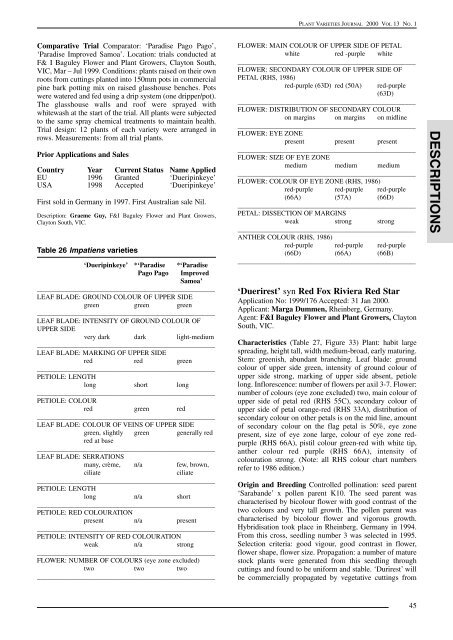53. Volume 13- Number 1 - IP Australia
53. Volume 13- Number 1 - IP Australia
53. Volume 13- Number 1 - IP Australia
Create successful ePaper yourself
Turn your PDF publications into a flip-book with our unique Google optimized e-Paper software.
DESCR<strong>IP</strong>TIONS<br />
PLANT VARIETIES JOURNAL 2000 VOL <strong>13</strong> NO. 1<br />
Comparative Trial Comparator: ‘Paradise Pago Pago’,<br />
‘Paradise Improved Samoa’. Location: trials conducted at<br />
F& I Baguley Flower and Plant Growers, Clayton South,<br />
VIC, Mar – Jul 1999. Conditions: plants raised on their own<br />
roots from cuttings planted into 150mm pots in commercial<br />
pine bark potting mix on raised glasshouse benches. Pots<br />
were watered and fed using a drip system (one dripper/pot).<br />
The glasshouse walls and roof were sprayed with<br />
whitewash at the start of the trial. All plants were subjected<br />
to the same spray chemical treatments to maintain health.<br />
Trial design: 12 plants of each variety were arranged in<br />
rows. Measurements: from all trial plants.<br />
Prior Applications and Sales<br />
Country Year Current Status Name Applied<br />
EU 1996 Granted ‘Dueripinkeye’<br />
USA 1998 Accepted ‘Dueripinkeye’<br />
First sold in Germany in 1997. First <strong>Australia</strong>n sale Nil.<br />
Description: Graeme Guy, F&I Baguley Flower and Plant Growers,<br />
Clayton South, VIC.<br />
Table 26 Impatiens varieties<br />
‘Dueripinkeye’ *‘Paradise *‘Paradise<br />
Pago Pago Improved<br />
Samoa’<br />
____________________________________________________<br />
LEAF BLADE: GROUND COLOUR OF UPPER SIDE<br />
green green green<br />
____________________________________________________<br />
LEAF BLADE: INTENSITY OF GROUND COLOUR OF<br />
UPPER SIDE<br />
very dark dark light-medium<br />
____________________________________________________<br />
LEAF BLADE: MARKING OF UPPER SIDE<br />
red red green<br />
____________________________________________________<br />
PETIOLE: LENGTH<br />
long short long<br />
____________________________________________________<br />
PETIOLE: COLOUR<br />
red green red<br />
____________________________________________________<br />
LEAF BLADE: COLOUR OF VEINS OF UPPER SIDE<br />
green, slightly green generally red<br />
red at base<br />
____________________________________________________<br />
LEAF BLADE: SERRATIONS<br />
many, crème, n/a few, brown,<br />
ciliate<br />
ciliate<br />
____________________________________________________<br />
PETIOLE: LENGTH<br />
long n/a short<br />
____________________________________________________<br />
PETIOLE: RED COLOURATION<br />
present n/a present<br />
____________________________________________________<br />
PETIOLE: INTENSITY OF RED COLOURATION<br />
weak n/a strong<br />
____________________________________________________<br />
FLOWER: NUMBER OF COLOURS (eye zone excluded)<br />
two two two<br />
____________________________________________________<br />
FLOWER: MAIN COLOUR OF UPPER SIDE OF PETAL<br />
white red -purple white<br />
____________________________________________________<br />
FLOWER: SECONDARY COLOUR OF UPPER SIDE OF<br />
PETAL (RHS, 1986)<br />
red-purple (63D) red (50A)<br />
red-purple<br />
(63D)<br />
____________________________________________________<br />
FLOWER: DISTRIBUTION OF SECONDARY COLOUR<br />
on margins on margins on midline<br />
____________________________________________________<br />
FLOWER: EYE ZONE<br />
present present present<br />
____________________________________________________<br />
FLOWER: SIZE OF EYE ZONE<br />
medium medium medium<br />
____________________________________________________<br />
FLOWER: COLOUR OF EYE ZONE (RHS, 1986)<br />
red-purple red-purple red-purple<br />
(66A) (57A) (66D)<br />
____________________________________________________<br />
PETAL: DISSECTION OF MARGINS<br />
weak strong strong<br />
____________________________________________________<br />
ANTHER COLOUR (RHS, 1986)<br />
red-purple red-purple red-purple<br />
(66D) (66A) (66B)<br />
____________________________________________________<br />
‘Duerirest’ syn Red Fox Riviera Red Star<br />
Application No: 1999/176 Accepted: 31 Jan 2000.<br />
Applicant: Marga Dummen, Rheinberg, Germany.<br />
Agent: F&I Baguley Flower and Plant Growers, Clayton<br />
South, VIC.<br />
Characteristics (Table 27, Figure 33) Plant: habit large<br />
spreading, height tall, width medium-broad, early maturing.<br />
Stem: greenish, abundant branching. Leaf blade: ground<br />
colour of upper side green, intensity of ground colour of<br />
upper side strong, marking of upper side absent, petiole<br />
long. Inflorescence: number of flowers per axil 3-7. Flower:<br />
number of colours (eye zone excluded) two, main colour of<br />
upper side of petal red (RHS 55C), secondary colour of<br />
upper side of petal orange-red (RHS 33A), distribution of<br />
secondary colour on other petals is on the mid line, amount<br />
of secondary colour on the flag petal is 50%, eye zone<br />
present, size of eye zone large, colour of eye zone redpurple<br />
(RHS 66A), pistil colour green-red with white tip,<br />
anther colour red purple (RHS 66A), intensity of<br />
colouration strong. (Note: all RHS colour chart numbers<br />
refer to 1986 edition.)<br />
Origin and Breeding Controlled pollination: seed parent<br />
‘Sarabande’ x pollen parent K10. The seed parent was<br />
characterised by bicolour flower with good contrast of the<br />
two colours and very tall growth. The pollen parent was<br />
characterised by bicolour flower and vigorous growth.<br />
Hybridisation took place in Rheinberg, Germany in 1994.<br />
From this cross, seedling number 3 was selected in 1995.<br />
Selection criteria: good vigour, good contrast in flower,<br />
flower shape, flower size. Propagation: a number of mature<br />
stock plants were generated from this seedling through<br />
cuttings and found to be uniform and stable. ‘Durirest’ will<br />
be commercially propagated by vegetative cuttings from<br />
45

















